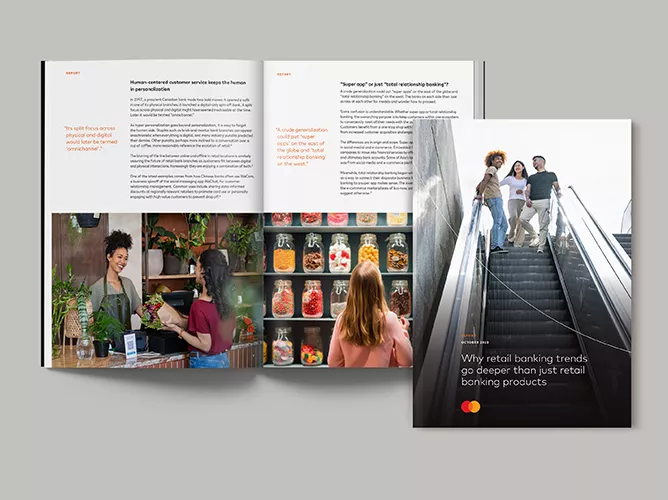Global
In 2020, we saw the world become more distanced, domestically focused and digital. In 2021, we expect to see the unlocking of some pent-up demand as socializing becomes possible and businesses realize some of the gains from investing in a more digital platform. The recovery is likely to be uneven with more calculated risk-taking from businesses and individuals and more targeted government policies.
We have seen a rapid acceleration in many pre-Covid-19 trends that are expected to be long-lasting: the shift to e-commerce, automation, contactless interaction, local delivery services and ‘tele-everything.’ Other pre-Covid trends, such as growth in the ‘experience economy,’ have been interrupted by the pandemic, but do not look to be a hard shift in consumer preferences. We estimate that about 20 to 30 percent of the peak in the Covid-related shift to e-commerce will stick.
The pandemic has created a multi-speed global recovery that favors low-touch over high-touch activity, high-income consumers over low, and has created a significant job divide for minorities, women and younger workers. Government and central bank stimulus policies that supported incomes and financial stability (and steered economies away from worst-case scenarios) are coming to an end and highlight the risk of greater economic scarring.
The deployment of vaccines and therapeutics are expected to keep the global economy on a gradual recovery path. As Main Street and shopping malls have seen many shops, bars and restaurants close, we expect to see an emerging demand for health products and services, personalized experiences, and products that offer more uniqueness.
With a heavy focus on the home, consumer spending on retail and services recovered quickly after significant global government stimulus in 2020. As travel spending was reallocated, home improvement and furniture and furnishings spending were among the strongest components of retail spending in the last year. Consumer spending growth in 2021 is expected to rely on the easing of mobility restrictions, digital innovation and additional government stimulus programs.
Shopping for the home and shopping local are trends expected to remain relatively sticky as consumers have shifted living and working away from central business districts in many Western countries. Notably, consumers in Western countries have invested heavily in durable assets – particularly homes and cars – in more suburban areas.
Mobility restrictions had a larger impact on higher-income individuals as their spending on travel, eating and shopping was impacted more significantly. Lower-income individuals continued to spend on essentials, such as rent and groceries and pulled back their spending by less. These trends tell us where we could see some unlocking of pent-up demand in 2021. Notably, elevated unemployment rates will provide a speed-limit effect to the recovery in consumer spending.
SpendingPulse™ 3m y/y growth rate (Aug 2020 - Oct 2020)
Source: SpendingPulse™, Mastercard Economics Institute
SpendingPulse™ reports and content, including estimated forecasts of spending trends do not in any way contain, reflect or relate to actual Mastercard operational or financial performance, or specific payment-card-issuer data.
We estimate that about 20-30 percent of the global peak in the Covid-related shift to e-commerce will be a permanent bump in the e-commerce share of overall retail spending. In the US, this implies a two-year acceleration in the ongoing shift to e-commerce from brick-and-mortar stores.
As e-commerce rapidly became a way to pandemic-proof a business, investment in digital was significant in 2020. Adoption by older generations and added convenience and lower costs for consumers will likely keep digital demand sticky in 2021. The accelerated shift to digital has played out in increasing use of automation, broader sets of industries working from home and more touchless experiences.
Going digital can enable financial inclusion, improve tax revenues and improve business productivity. However, going digital can also come at the cost of low-skilled employment, which accelerates the demand for lifelong learning and workforce re-training. Online and anytime shopping ultimately smooth out the day and time when consumers make purchases, with fewer peak periods and fewer high-touch jobs.
As travel disruptions persist, we highlight the net tourism deficit vs. surplus countries around the world. Places where more tourism dollars go out rather than in during normal times (i.e., those who run a deficit) — such as China, the UK and Singapore (shown in the chart) —could benefit from these would-be-travelers forced to stay within their borders, keeping their holidays and spending domestic. International travel, especially long haul, will be in a multi-year recovery, held back by bottlenecks on the supply side. These challenges include reduced aircraft availability due to age, maintenance bottlenecks for parked inventory, repair and parts replacement logistics and supplies, and availability of flight deck crews due to re-certification and minimum flight requirements.
Road trips and the ability to control the environment while limiting interaction is likely to continue in 2021. However, there is significant pent-up demand from accumulated credits and miles that are likely to result in a flurry of rebooking flights as mobility restrictions are lifted.
The health pass, which travelers can provide to show proof of vaccination or a negative recent Covid test, will likely be in focus. It complements the emergence of trusted travel bubbles.
Source: World Bank, Mastercard Economics Institute
On top of the significant impacts to bars and restaurants, businesses in sectors or locations that rely on a consistent flow of commuters and tourists have been badly hit. As a likely trend to what we see globally, 74 percent of the new retail businesses registered since April 2020 were non-store retailers (i.e., online).
New business creation is expected to be driven by micro-businesses emerging online, existing businesses establishing a separate online presence, and the ‘formalizing’ of businesses by officially registering to take advantage of government programs. Meanwhile, uncertain demand, tighter lending conditions and travel and entertainment challenges will impair new brick-and mortar-business creation around the world in 2021. We see most new business openings in 2021 opting for virtual storefronts to reach more customers while minimizing costs.
After years of trade wars and the exposure of the vulnerability of supply chains around the world, we have seen greater emphasis on local production with more control, such as manufacturing and tech sovereignty. Supply chains face pressure to shift from ‘just in time’ to ‘just in case’ inventory management. In 2021, watch for companies shifting production and supply chains to adding alternative sources for a more limited product line and focusing on more localized production.
An economy’s ability to continue to recover in 2021 will rely heavily on the extent to which governments can provide timely and targeted fiscal stimulus, service their debt and meet prior obligations (including the payments to public pensions). While fiscal stimulus programs dwarfed those from the Global Financial Crisis, the 2020 stimulus plans were not as large as headlines suggested once you adjust for timing and money spent versus guarantee or deferral programs. Expiring stimulus is a looming risk for 2021 and beyond but is more likely to be more of a ‘slope’ than an actual ‘cliff’ effect.
Restrictions in mobility have impacted migration trends and may widen skills gaps in the labor force. This means labor-providing countries such as India, the Philippines and Nigeria end up with higher local unemployment and lower remittance income. Labor-receiving countries, such as the United States and the United Kingdom, end up with a labor shortage.
Major central bank balance sheets saw unprecedented expansions in 2020, which, along with ultra-low interest rates, has helped boost asset price inflation – particularly equity and home prices – and corporate debt issuance. Balance sheet expansion by the US Federal Reserve in 6 months was as big as that seen over the prior 12 years. Even emerging markets have jumped on board the quantitative easing bandwagon, which could bring a broader discussion of central bank independence back into question in 2021.
Source: World Bank, Mastercard Economics Institute
As we consider a full range of risks (outlined in the heatmap below where red implies greater risk), the question of debt sustainability will likely be a key focus in 2021. Countries are looking to service their larger debt burdens in the face of slower growth rates and elevated unemployment. The risk of higher consumer delinquencies and defaults is significant in the face of elevated unemployment rates, expiring government stimulus programs and potential delays in the deployment of vaccines and therapeutics.
There is a growing focus for governments on the potential fallout from climate change. Climate change carries both short- and long-term risks that are not fully appreciated, including existential risks for many small coastal and inland nations.
Stressed economies have led to stressed politics and unrest around the world, which deserve close attention. The link between high unemployment and social unrest is likely to remain an issue in 2021.
Source: Oxford Economics, Oxford University, Johns Hopkins CSSE, Bloomberg, IMF, Mastercard Economics Institute
data updated as of November 30, 2020
Notes & Disclaimer
About the Mastercard Economics Institute
Mastercard Economics Institute launched in 2020 to analyze macroeconomic trends through the lens of the consumer. A team of economists, analysts and data scientists draws on Mastercard insights - including Mastercard SpendingPulse™ - and third-party data to deliver regular reporting on economic issues for key customers, partners and policymakers.
Disclaimer
© 2020 Mastercard International Incorporated. All rights reserved.
Disclaimer: This Mastercard Economics Institute presentation (This “Presentation”) and content or portions thereof may not be accessed, downloaded, copied, modified, distributed, used or published in any form or media, except as authorized by Mastercard. This presentation and content are intended solely as a research tool for informational purposes and not as investment advice or recommendations for any particular action or investment and should not be relied upon, in whole or in part, as the basis for decision-making or investment purposes. This presentation and content are not guaranteed as to accuracy and are provided on an “as is” basis to authorized users, who review and use this information at their own risk. This presentation and content, including estimated economic forecasts, simulations or scenarios from the Mastercard Economics Institute, do not in any way reflect expectations for (or actual) Mastercard operational or financial performance.
US & Canada
E-commerce adoption soared following measures to control the virus. Still, the upward trajectory may hit some bumps as consumers wait for additional government support and the lifting of mobility restrictions as vaccines are deployed. Meanwhile, consumers are now shopping anytime and closer to home with fewer peak shopping periods throughout the day and week. The e-commerce shifts are great for digital evolution and productivity but will be challenging for the labor market recovery.
This recession has impacted minority-owned enterprises to a greater degree while we have seen increased income inequality with larger job losses for the young. We should expect a new wave of bankruptcies, particularly for small businesses in the US, as businesses face a slow recovery and the hard choice of taking on more debt or closing shop.
The timing and size of the next round of US fiscal stimulus will set the tone for the recovery. Meanwhile, after years of budget surpluses, Canada has opted for an aggressive fiscal stimulus that boosted consumer confidence and spending. In both economies, retail spending has gone back to the trend growth seen before the shock, while spending on travel & entertainment lags.
The suburban shift has driven residential property prices higher in non-urban centers in both economies. In Canada, house prices are rising after stagnating in 2018 and 2019 but have re-sparked concerns of elevated household debt and debt sustainability. Spending in and around the home has been the main focus for mobility-restricted consumers who have also redirected spending to other hard assets like autos. These themes, along with a focus on health and well-being, are expected to dominate in 2021.
Mastercard Client-Only Session
Access to this session is limited to invited participants. The provided email is not authorized to access this resource. Please reach out to your Mastercard Representative to request access.
Latin America & Caribbean
A double hit of a slowdown in international tourism and a drop in remittance flows will be detrimental to growth, especially for many of the region’s small, externally-positioned economies.
Beyond different Covid approaches, fiscal approaches vary widely in the region, as seen in Brazil and Mexico. For Brazil, which opted for an aggressive support program, larger in scale than some advanced economies, the challenge is when the support ends. The massive ‘coronavoucher’ subsidy program more than offset lost income for many recipients. For Mexico, the challenge is how quickly the economy can bounce back from the economic scarring caused by such a deep downturn.
Lack of room for government stimulus across the region will make the task of jumpstarting economies much more difficult and may undermine political stability and potential long-term growth. Reforms that could boost growth in the longer term may be difficult in 2021 in a more fractured political environment.
Mobility restrictions have impacted migration trends and may widen skills gaps in the labor force. This means labor-providing countries such as Mexico, Colombia, Ecuador and Peru end up with higher local unemployment and lower remittance income.
Europe
The UK economy has been one of the hardest hit by Covid, while the waves of new cases later in the year put the entire region on its back foot. Wounds left from the pandemic will likely restrict the appetite for both consumer spending and business investment in 2021.
The stop-start nature of Europe’s recovery is likely to be a dominant issue through the first half of 2021, at least. Ground travel became the dominant mode of transport through the pandemic, leading to a similar pattern of ‘out of the way’ spending seen throughout the world.
The pandemic has created a multi-speed recovery that favors low-touch over high-touch activity, high-income consumers over low, and has created a significant job divide for minorities, women and younger workers. Government and central bank stimulus policies that supported incomes and financial stability and steered economies away from worst-case scenarios are coming to an end and highlight the risk of greater economic scarring.
The deployment of vaccines and therapeutics are expected to keep the economy on a gradual recovery path. As Main Street and shopping malls have seen many shops, bars and restaurants close, we expect to see an emerging demand for health products and services, personalized experiences and products that offer more uniqueness.
Asia Pacific
Most economies in Asia Pacific benefit from having contained Covid, but external demand and international travel are likely to hinder the recovery as the rest of the world catches up. Economies within the region with stronger domestic growth drivers are better positioned in 2021 as fiscal support and domestic tourism are unlikely to fully plug the gap.
We have seen a rapid acceleration in many pre-Covid trends that are expected to be long-lasting: the shift to e-commerce, automation, contactless interaction. With the AP region standing out with the fastest growing e-commerce adoption pre-Covid, we estimate that about 20-30 percent of the Covid-related shift to e-commerce will stick.
Many of the AP economies that contained the virus have seen recoveries in retail and services sectors as they re-open businesses post shutdowns. China stands out in terms of being a significant driver of global growth for 2021. The global deployment of vaccines and therapeutics are expected to keep the AP economy on a gradual recovery path.
Middle East & Africa
Many of the oil-importing nations entered the crisis with already vulnerable economic imbalances. Expect a gradual and patchy recovery in 2021, including oil-importing economies that depend on foreign worker remittances. The shift to digital was sharp in the Middle East & Africa (MEA), the smallest and second slowest growing e-commerce marketplace among the regions covered in this report. We estimate that 20-30 percent of the Covid-related surge in e-commerce to be a permanent bump in the e-commerce share of overall retail spending.
The region faces major challenges, including a global recession, the collapse of international tourism (particularly for East Africa), declines in foreign worker populations (half of the Gulf Cooperation Council (GCC) population is estimated to be non-citizen) and oil price weakness. Having handled Covid relatively well, the economic fallout includes large-scale job losses and severely weakened public finances in already highly indebted economies. Consumer tax increases to help plug fiscal holes may dampen spending recoveries.
The pandemic has created a multi-speed global recovery that favors low-touch over high-touch activity, high-income consumers over low. Young and fast-growing populations across many economies in MEA help to support the long-term growth outlook. However, the burden of large groups of unemployed youths (particularly in places like South Africa) can severely impair growth prospects. Diversification of oil-dependent economies away from oil dependency has a renewed importance in the aftermath of Covid.







